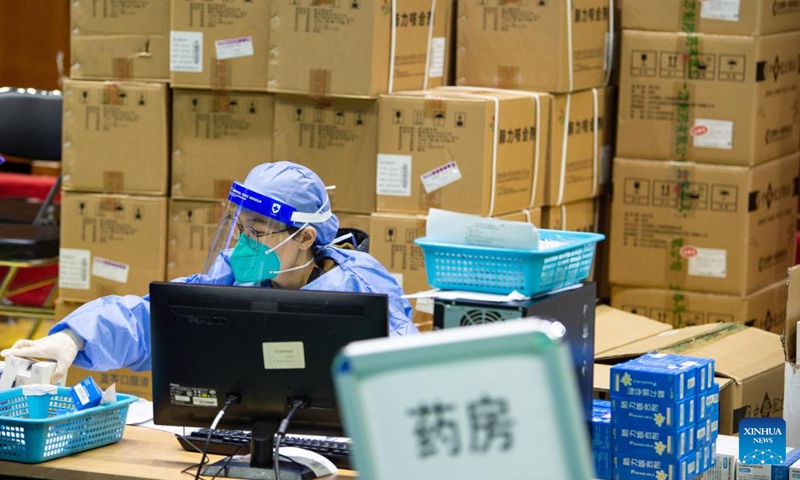
A medical worker dispenses medicine in a makeshift fever clinic of Beijing Chaoyang Hospital in Chaoyang Gymnasium in Beijing, capital of China, Dec 24, 2022. In order to facilitate fever patients to seek medical treatment and ensure residents' medical needs, some hospitals in Beijing set up makeshift fever clinics in gymnasiums to provide services such as diagnosis, prescription issuing and medicine dispensing for citizens. Photo:Xinhua
Many places in China, including Beijing, Henan, Hainan and Sichuan provinces, have launched the second round of surveys to learn about the situation of residents infected with the coronavirus. According to the results released so far, the infection rate in Sichuan has exceeded 63.5 percent, which is 16.59 percent higher than the previous survey.
The purpose of the investigation is to keep abreast of the pattern of the epidemic situation and provide targeted medical services to the public, according to local health authorities. The survey is carried out in the form of an online questionnaire, and anyone can participate anonymously.
The Sichuan Center for Disease Control and Prevention released the second round of survey results on December 24. As of 12:00 am on December 25, a total of 158,506 people had taken part in the survey, covering 183 cities and counties in 21 cities and prefectures.
According to the survey, only two of 21 regions had an infection rate of less than 50 percent. Moreover, the infection rate of 54.91 percent in rural areas is lower than that of 65.42 percent in urban areas.
The survey results specifically confirmed that although the infection rate in this survey was 63.52 percent, another 28 percent of the respondents had shown symptoms of COVID-19, including fever and cough, even though no nucleic acid or antigen was detected. Therefore, the actual infection rate of the coronavirus is likely higher than 63.52 percent.
Around 38.62 percent of the patients had a course of illness lasting more than five days, and the seniors aged 65 and above experienced illness lasting more than 10 days, according to the results.
The Hainan Center for Disease Control and Prevention said in a statement on its official account on Monday that it would conduct a second province-wide survey to learn about the infection situation in the province. "Whether you participated in the first round of the survey or not, you are welcome to participate and provide valuable information," the statement read.
The results of the first round of the survey in Hainan were released on December 22, with 18,905 people having filled out the questionnaire by 21:00 pm on December 20. 1051 people, accounting for 5.6 percent of the surveyed, reported that they were infected with the coronavirus from December 12 to 18.
In addition, in the last survey in Hainan, 498 people reported positive nucleic acid tests, 346 people had positive antigen tests, and 207 people had obvious symptoms but were not tested.
From December 12 to 18, the overall trend of COVID-19 infection in Hainan Province showed that the number of infected people was increasing day by day. The most common symptom was fever, accounting for 86 percent, followed by muscle soreness at 73 percent, with coughs appearing for 70 percent of respondents.
In terms of the questions listed in the survey, the focus of the investigation by health authorities across the country is also different. In East China's Jiangsu Province, the questionnaire asked about vaccination dates and previous infections, while in East China's Shandong Province, health authorities wanted to know about residents' stockpiles of drugs at home.
China's National Health Commission (NHC) announced that it would stop publishing daily COVID-19 case data from Sunday handing the duty over to the Chinese Center for Disease Control and Prevention (China's CDC).
Entrusted by the CDC, Peking Union Medical College conducted a survey on the national infection situation on the Chinese social media platform Sina Weibo that finished on December 21 with about 470,000 people participating. The college is analyzing the results, which will serve as a vital reference for the country's epidemic management measures, Weibo announced Sunday.
Observers said handing over the epidemic data calculation to a technical organization is a reasonable move to provide professional epidemic figures.
The surge of infected friends, colleagues and families and the long lines at the fever clinics at hospitals across the country are all indications that the Chinese cities are experiencing infection peaks after the 10 new optimized COVID response measures were implemented.
In face of surging cases, the NHC has already taken steps, requiring public hospitals to expand the ICU to four percent of the total beds and convert another four percent of total beds to ICU beds.
Meanwhile, medical institutions and authorities at all levels are ramping up efforts to allocate resources to relieve pressure among medical institutes, including boosting fever clinic capacity and increasing reserves of COVID-19 medication.
Global Times




